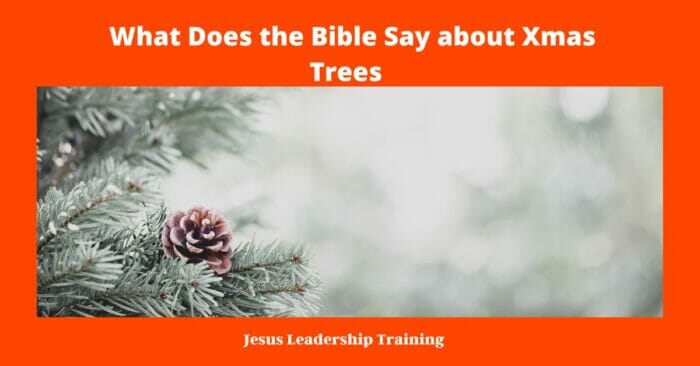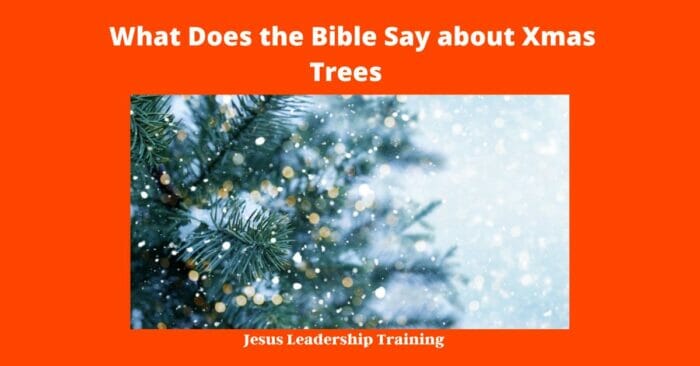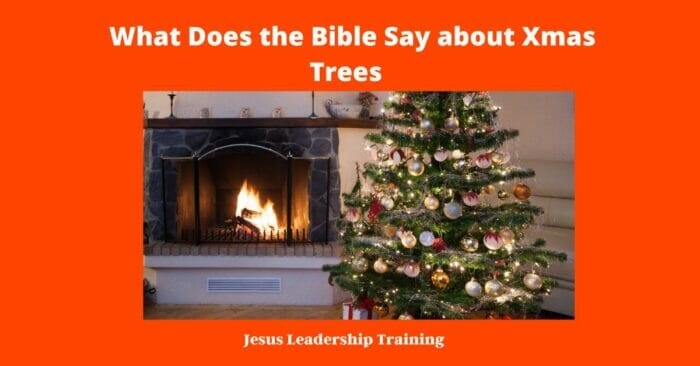What Does the Bible Say about Xmas Trees – The Bible does not explicitly mention Christmas trees, but there are many historical references that suggest that the use of evergreen trees at Christmas time is a tradition that has been around since ancient times.
Table of Contents
What Does the Bible Say about Xmas Trees
The Bible is a sacred document that has been part of human history for thousands of years. It contains instructions and laws that help guide us in our lives and how we should treat one another. When it comes to certain topics like Christmas trees, the Bible has a lot to say. Some people might wonder if the Bible considers a Christmas tree an abomination. In this blog post, we will explore what the Bible has to say about Christmas trees. We will look at passages from the King James Version of the Bible, as well as other religious sources, to get an idea of what the Bible really says about Christmas trees.
Bible Passages About Christmas Trees
The Bible does not mention Christmas trees by name, but it does have much to say about trees in general. In the Old Testament book of Deuteronomy, it states that “You shall not plant any tree as an Asherah beside the altar of the Lord your God” (Deuteronomy 16:21). This is just one example of how the Bible speaks about trees in relation to worship. In the New Testament, Jesus also speaks about trees in relation to worship and obedience. He says, “Every tree that does not bear good fruit is cut down and thrown into the fire” (Matthew 7:19). These passages show that the Bible speaks of trees in relation to worship and obedience.

King James Version and Christmas Trees
The King James Version of the Bible does not mention Christmas trees by name, but it does contain many passages about trees in general. In the Old Testament book of Genesis, it states, “And God said, Let the earth bring forth the living creature after his kind, and the tree yielding fruit after his kind” (Genesis 1:11). This passage speaks of the creation of trees and how they were made to bear fruit. In the New Testament book of John, Jesus says, “I am the vine, you are the branches. He who abides in Me, and I in him, bears much fruit” (John 15:5). This passage speaks of how Jesus is the vine and we are the branches, and how we should bear fruit for God.
What is the History of Using a Xmas Tree on Christmas
Christmas trees have been an important part of Christmas celebrations for centuries. The tradition of having a Christmas tree dates back to 16th century Germany and has since spread to many countries around the world.
The first recorded use of a Christmas tree was in 1521 in Germany, where a fir tree was decorated with edible treats, such as apples and nuts. This began the tradition of hanging ornaments on the tree.
The popularity of the Christmas tree spread throughout Europe in the late 1500s and 1600s. It made its way to England in the 17th century, where it was referred to as a “Yule Tree.” By the 19th century, the Christmas tree was firmly entrenched in the holiday celebrations of all European countries.

In the United States, the tradition of the Christmas tree was brought to America by German immigrants in the late 1700s. The tree was decorated with white candles, fruits, and paper roses. This tradition was further popularized by Queen Victoria and Prince Albert, who were pictured in a magazine surrounded by a Christmas tree in 1848.
Today, Christmas trees are a staple of holiday celebrations. Most Christmas trees are decorated with a combination of ornaments, lights, and tinsel. While the history of the Christmas tree is fascinating, it has become an important symbol of the holiday season for many people around the world. It is a reminder of the joy of the season and a reminder of the people we love.
Jesus Christ and the Christmas Tree
When it comes to Jesus Christ and the Christmas tree, there is no mention of the tree in the Bible. However, Jesus does speak of trees in relation to obedience and worship. For example, in the New Testament book of Matthew, Jesus says, “Every tree that does not bear good fruit is cut down and thrown into the fire” (Matthew 7:19).
This passage speaks of how we should bear good fruit for God. In the Old Testament book of Jeremiah, it states, “Thus says the Lord of hosts: Do not learn the way of the Gentiles; do not be dismayed at the signs of heaven, for the Gentiles are dismayed at them” (Jeremiah 10:2). This passage speaks of how we should not follow the ways of the Gentiles and how we should worship God alone.
Bible Verses About Christmas Trees
Although the Bible does not mention Christmas trees by name, there are some passages that speak of trees in relation to worship and obedience. In the Old Testament book of Deuteronomy, it states, “You shall not plant any tree as an Asherah beside the altar of the Lord your God” (Deuteronomy 16:21). This passage speaks of how we should not worship false gods and how we should only worship God. In the New Testament book of Matthew, Jesus says, “Every tree that does not bear good fruit is cut down and thrown into the fire” (Matthew 7:19). This passage speaks of how we should bear good fruit for God.

KJV and the Christmas Tree
The King James Version of the Bible does not mention Christmas trees specifically, but it does contain many passages about trees in general. For example, in the Old Testament book of Genesis, it states, “And God said, Let the earth bring forth the living creature after his kind, and the tree yielding fruit after his kind” (Genesis 1:11). This passage speaks of how God created trees and how they were meant to bear fruit. In the New Testament book of John, Jesus says, “I am the vine, you are the branches. He who abides in Me, and I in him, bears much fruit” (John 15:5). This passage speaks of how Jesus is the vine and we are the branches, and how we should bear fruit for God.
Pagan Tree Worship and the Christmas Tree
Christmas trees have been used for centuries as a symbol of the winter season. The tradition of using a Christmas tree as a pagan tree dates back to pre-Christian times. The use of evergreen trees, wreaths, and garlands in winter celebrations is a custom that long predates the Christmas holiday.
The Romans, Celts, and Germanic peoples all celebrated the winter solstice with feasts and festivals that included evergreen branches. This was done in the hopes that the evergreen trees would bring luck and protection from evil spirits during the cold, dark months of winter.
The first recorded use of an evergreen tree as part of a Christmas celebration was in 1605 in Germany. The Protestant reformer Martin Luther is said to have decorated a tree with candles in an effort to recreate the beauty of the stars he could see outside his window. The tradition of bringing an evergreen tree into the home at Christmas time soon spread throughout Europe.

In the 1800s, the Christmas tree began to gain popularity in the United States. The German immigrants who had brought the tradition with them to America started to decorate the trees with candy, fruits, and homemade ornaments. By the late 1800s, the Christmas tree had become a popular tradition in America.
The Christmas tree has become a symbol of the Christmas season for many people around the world. It is now used to decorate homes, churches, and businesses during the holiday season. The use of an evergreen tree as a pagan tree was a tradition that predated Christianity and has become an important part of modern celebrations of the winter season.
Is It a Sin to Have a Christmas Tree?
The debate around whether or not having a Christmas tree is a sin has been raging for centuries. While the answer to the question is ultimately up to each individual, it is important to consider the history of the Christmas tree and its various religious meanings.
Christmas trees have been around for centuries, with the earliest records of evergreen trees being decorated for the winter solstice dating back to pagan traditions in Germany and other parts of Europe. However, the modern-day Christmas tree is said to have originated in the 16th century when German Christians began decorating evergreen trees with apples, paper roses, and candles to represent the Garden of Eden. These decorated trees were used as a way to celebrate the birth of Jesus and the coming of the new year.
In the 17th century, the Christmas tree was adopted by other countries, including Britain, France, and the United States. While some Protestant denominations had mixed feelings about the idea of a decorated tree, it eventually became a commonplace part of the Christmas season.
The debate around whether or not having a Christmas tree is a sin began in the 19th century when some Christians believed that the Christmas tree was a pagan symbol and therefore a form of idolatry. While Protestants still disagreed with this idea, Roman Catholics began to use the tree to represent the Tree of Life from the Garden of Eden. This allowed for the acceptance of the tree as a religious symbol and its use within the Catholic Church.
Today, the Christmas tree continues to be a popular holiday symbol, found in both Christian and non-Christian homes. While some people consider it to be a sin, many others see it purely as a secular symbol of the season. Ultimately, the decision as to whether or not to have a Christmas tree is a personal one that each individual must make for themselves. No matter what your religious beliefs are, it is important to recognize the history of the Christmas tree and its various meanings.
Christmas Trees and What They Symbolize(Religious Symbolism)
Christmas is a time of the year that is filled with joy and celebration. It is celebrated all over the world, and it is associated with a variety of symbols. One of the most popular symbols of Christmas is the Christmas tree.
The Christmas tree has been a popular symbol of Christmas for centuries. It is believed that the use of evergreen trees at Christmas dates back to the ancient pagan celebrations of winter solstice. At this time of year, it was believed that cutting evergreen trees or bringing them indoors would bring in good luck and protection from evil spirits.
In the early Christian era, the Christmas tree was a symbol of Jesus Christ and the Christian faith. The evergreen of the Christmas tree was seen as a symbol of everlasting life and the promise of eternal life given by Jesus. Christians also associate the triangle shape of the tree with the Holy Trinity – God the Father, God the Son, and God the Holy Spirit.
The decorations that are placed on the Christmas tree also hold a special significance. The lights of the tree are seen as symbols of Jesus, the light of the world, and the presents underneath the tree represent the gifts given by the Three Wise Men. The star on top of the tree is meant to remind us of the star that guided the wise men to the stable where Jesus was born.
In addition to religious symbolism, the Christmas tree is also seen as a symbol of family and togetherness. As we decorate the tree together, it is a reminder of the love that we have for each other and the joy of celebrating the holiday season with our loved ones.
No matter what the origins of the Christmas tree may be, it is undeniable that it has become an important symbol of the Christmas season. As we celebrate Christmas, the Christmas tree is a reminder of the religious and family values that are the heart of the holiday.
Does the Bible Approve of Christmas Trees?
The Christmas tree is a beloved symbol of the holiday season, but does the Bible approve of them? The answer to this question is a bit complicated because there is no explicit mention of the Christmas tree in the Bible. However, there are several references to trees and their symbolism in the Bible that can help us answer this question.
In the Old Testament book of Genesis, God is said to have planted a garden in Eden and placed two trees at the center. These were the Tree of Life and the Tree of the Knowledge of Good and Evil. The Tree of Life was a symbol of eternal life and the Tree of Knowledge was a symbol of discernment and wisdom. This symbolism of trees has been echoed in art, literature, and religion throughout the centuries.
In the New Testament, Jesus is known as “The Tree of Life” and is said to have been born in a manger surrounded by animals and trees. This could be interpreted as a representation of the Tree of Life in the Garden of Eden. In the Bible, trees are often seen as symbols of abundance, fertility, and life.
The custom of bringing evergreen trees into the home during winter months dates back to ancient pagan traditions. This was done in order to symbolize the hope of life and renewal during the cold winter months. This practice was eventually adopted by the Church and incorporated into Christian celebrations like Christmas.
In conclusion, the Bible does not explicitly mention Christmas trees, but it does contain several references to trees and their symbolism. Taking these references into consideration, it is reasonable to conclude that the Bible does approve of the Christmas tree as a symbol of hope and renewal.
Final Thoughts – What Does the Bible say about Xmas Trees
The Bible does not specifically mention Christmas trees, but it does have much to say about trees in general. In the Old Testament book of Deuteronomy, it states, “You shall not plant any tree as an Asherah beside the altar of the Lord your God” (Deuteronomy 16:21). This is just one example of how the Bible speaks about trees in relation to worship. In the New Testament, Jesus also speaks about trees in relation to worship and obedience. He says, “Every tree that does not bear good fruit is cut down and thrown into the fire” (Matthew 7:19).
These passages show that the Bible speaks of trees in relation to worship and obedience. Therefore, it is safe to say that the Bible does not approve of pagan tree worship and that it is best to worship God alone. Christmas trees can be seen as a symbol of hope, peace, joy, and love, and they are a wonderful way to celebrate the birth of Jesus Christ.




